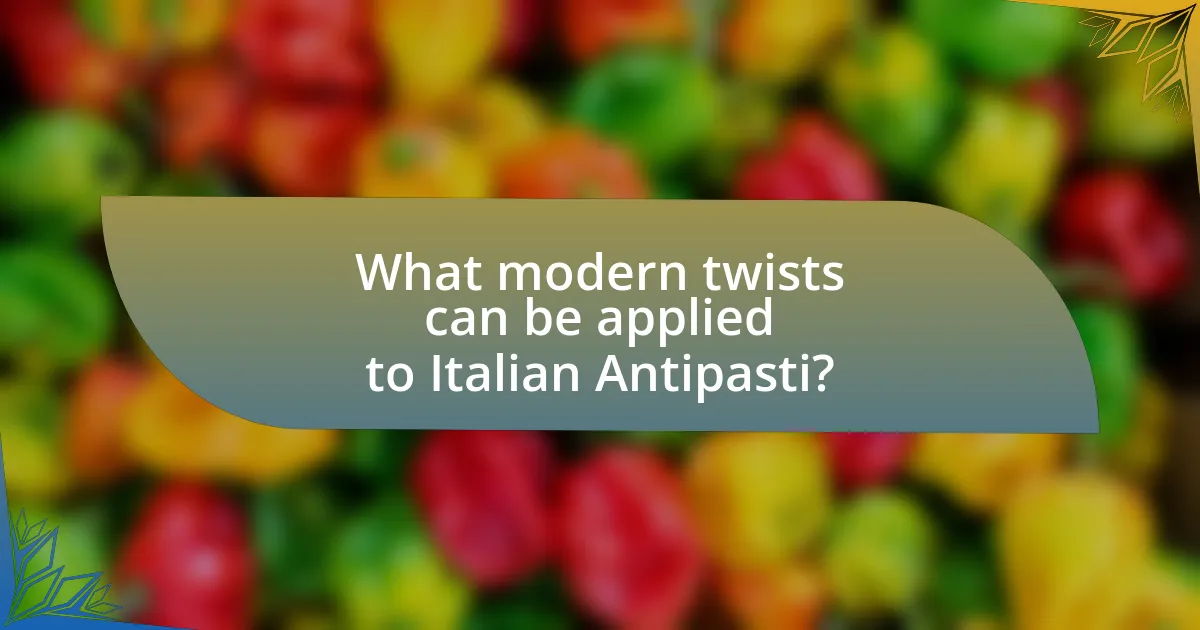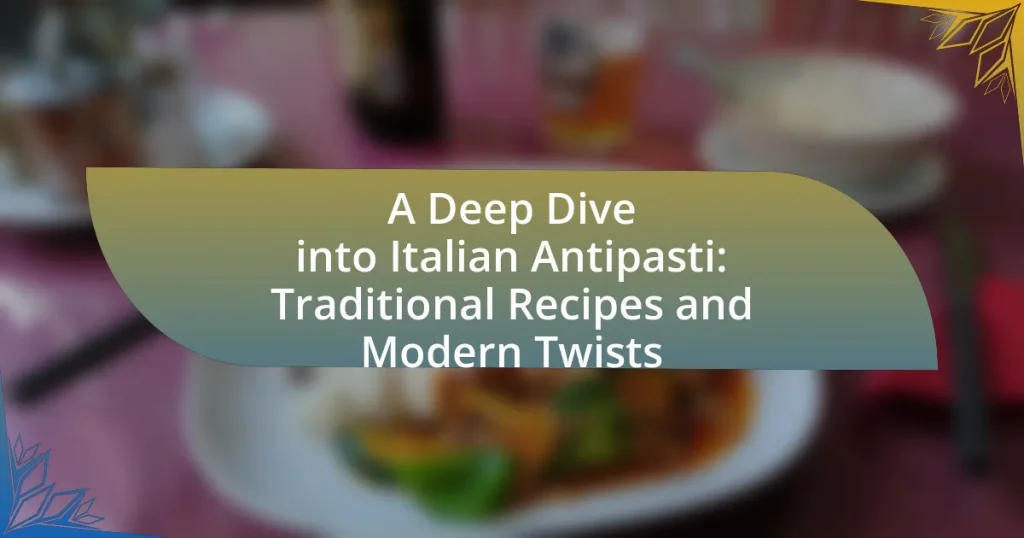Italian antipasti are a diverse array of appetizers integral to Italian cuisine, typically featuring cured meats, cheeses, olives, marinated vegetables, and bread. This article explores the historical significance of antipasti, their communal nature, and how they differ from other appetizers. It delves into traditional and modern variations, including popular cold and hot dishes, essential ingredients, and regional influences. Additionally, the article discusses innovative adaptations for contemporary tastes, optimal serving practices, and beverage pairings, providing a comprehensive overview of how antipasti can enhance the dining experience.

What are Italian Antipasti?
Italian antipasti are a variety of appetizers served before the main meal in Italian cuisine. These dishes typically include a selection of cured meats, cheeses, olives, marinated vegetables, and bread, showcasing regional ingredients and flavors. Antipasti play a significant role in Italian dining culture, often enjoyed as a communal dish to stimulate the appetite and encourage social interaction. The tradition of antipasti dates back to ancient Rome, where small bites were served to accompany wine, evolving over centuries into the diverse offerings found today.
How do Italian Antipasti differ from other appetizers?
Italian antipasti differ from other appetizers primarily in their emphasis on a variety of cold and cured ingredients, often served in a communal style. Antipasti typically include items such as cured meats, cheeses, marinated vegetables, and olives, reflecting regional Italian flavors and seasonal ingredients. This contrasts with many other appetizers, which may focus on hot, cooked dishes or single-item servings. The communal aspect of antipasti encourages sharing and social interaction, a hallmark of Italian dining culture, further distinguishing them from appetizers in other culinary traditions that may prioritize individual portions or different flavor profiles.
What are the key characteristics of traditional Italian Antipasti?
Traditional Italian antipasti are characterized by a variety of small dishes served as appetizers, emphasizing fresh, high-quality ingredients. These dishes often include cured meats like prosciutto and salami, cheeses such as mozzarella and pecorino, marinated vegetables, olives, and bread. The presentation is typically colorful and diverse, reflecting regional variations across Italy. Antipasti are designed to stimulate the appetite and are often enjoyed with wine, showcasing Italy’s culinary heritage and communal dining culture.
Why are Antipasti important in Italian cuisine?
Antipasti are important in Italian cuisine because they serve as a traditional starter that stimulates the appetite and sets the tone for the meal. This course typically includes a variety of cured meats, cheeses, olives, and marinated vegetables, showcasing regional ingredients and culinary techniques. Historically, antipasti reflect Italy’s diverse food culture, with each region offering unique variations that highlight local flavors and customs. For example, in regions like Tuscany, antipasti may feature crostini topped with chicken liver pâté, while in the south, you might find a selection of pickled vegetables. This variety not only enhances the dining experience but also emphasizes the communal aspect of Italian meals, encouraging sharing and conversation among diners.
What types of Antipasti are commonly served?
Common types of antipasti served include bruschetta, cured meats, marinated vegetables, olives, and cheese platters. Bruschetta typically consists of grilled bread topped with tomatoes, garlic, and basil, while cured meats like prosciutto and salami are often featured for their rich flavors. Marinated vegetables, such as artichokes and peppers, add a tangy contrast, and olives provide a salty bite. Cheese platters may include varieties like mozzarella, pecorino, and gorgonzola, showcasing Italy’s diverse cheese-making traditions. These antipasti reflect regional ingredients and culinary practices, making them a staple in Italian cuisine.
What are the most popular cold Antipasti dishes?
The most popular cold Antipasti dishes include Caprese salad, bruschetta, marinated olives, and prosciutto with melon. Caprese salad features fresh mozzarella, tomatoes, and basil, highlighting the simplicity of Italian cuisine. Bruschetta consists of grilled bread topped with a mixture of diced tomatoes, garlic, and basil, showcasing fresh ingredients. Marinated olives offer a variety of flavors and textures, often seasoned with herbs and spices. Prosciutto with melon combines the sweetness of melon with the saltiness of cured ham, creating a classic Italian pairing. These dishes are staples in Italian cuisine, often served as appetizers to stimulate the appetite before the main course.
Which hot Antipasti are favorites among Italians?
Popular hot antipasti among Italians include arancini, which are rice balls filled with cheese or meat and deep-fried, and bruschetta al pomodoro, toasted bread topped with fresh tomatoes and garlic. Additionally, calamari fritti, or fried squid, is a beloved choice, often served with a side of marinara sauce. These dishes are staples in Italian cuisine, frequently enjoyed as appetizers in restaurants and homes alike.
How are Antipasti traditionally prepared?
Antipasti are traditionally prepared by assembling a variety of cold dishes that include cured meats, cheeses, olives, marinated vegetables, and bread. The preparation often involves selecting high-quality ingredients, such as prosciutto, salami, and fresh mozzarella, which are then arranged on a platter for serving. This practice dates back to ancient Roman times, where the concept of serving small bites before the main meal was common, emphasizing the importance of fresh, local produce and artisanal methods in Italian cuisine.
What ingredients are essential for making classic Antipasti?
Essential ingredients for making classic Antipasti include cured meats, cheeses, olives, marinated vegetables, and bread. Cured meats such as prosciutto and salami provide rich flavors, while cheeses like mozzarella and Parmigiano-Reggiano add creaminess. Olives contribute a briny taste, and marinated vegetables, such as artichokes and peppers, offer a tangy contrast. Bread, often served as a base or accompaniment, completes the dish. These components reflect traditional Italian culinary practices, emphasizing fresh, high-quality ingredients.
How do regional variations influence Antipasti recipes?
Regional variations significantly influence Antipasti recipes by incorporating local ingredients and culinary traditions. For example, in Northern Italy, Antipasti often feature cured meats like speck and cheeses such as Asiago, reflecting the region’s agricultural practices. In contrast, Southern Italian Antipasti may include olives, capers, and seafood, showcasing the Mediterranean influence and availability of fresh produce. This diversity is further evidenced by the use of specific herbs and spices unique to each region, such as basil in the South and thyme in the North, which enhance the flavor profiles of the dishes. Thus, regional ingredients and cultural practices shape the variety and preparation of Antipasti across Italy.

What modern twists can be applied to Italian Antipasti?
Modern twists that can be applied to Italian antipasti include incorporating global flavors, utilizing plant-based ingredients, and presenting dishes in innovative formats. For instance, traditional bruschetta can be enhanced with toppings like avocado or kimchi, merging Italian and Asian influences. Additionally, plant-based cheeses and charcuterie can replace dairy and meat options, catering to vegan diets while maintaining the essence of antipasti. Creative presentations, such as antipasti skewers or deconstructed platters, also modernize the experience, making it visually appealing and interactive. These adaptations reflect contemporary culinary trends while honoring the original spirit of antipasti.
How can traditional recipes be adapted for contemporary tastes?
Traditional recipes can be adapted for contemporary tastes by incorporating modern ingredients, adjusting cooking techniques, and emphasizing health-conscious options. For instance, classic Italian antipasti can be modified by using gluten-free bread or plant-based cheeses to cater to dietary restrictions. Additionally, chefs can experiment with flavor profiles by introducing global spices or fusion elements, such as adding avocado to bruschetta. This approach not only maintains the essence of traditional dishes but also aligns with current culinary trends, such as sustainability and health awareness, making them more appealing to today’s consumers.
What innovative ingredients can be incorporated into Antipasti?
Innovative ingredients that can be incorporated into antipasti include smoked sea salt, pickled vegetables, and artisanal cheeses. Smoked sea salt enhances the flavor profile of traditional ingredients, while pickled vegetables add a tangy crunch that contrasts with richer items. Artisanal cheeses, such as truffle-infused or goat cheese with herbs, introduce unique flavors that elevate the dish. These ingredients reflect modern culinary trends that focus on bold flavors and creative combinations, aligning with the evolving nature of antipasti in contemporary cuisine.
How do presentation styles change the perception of Antipasti?
Presentation styles significantly influence the perception of Antipasti by affecting visual appeal, perceived quality, and overall dining experience. For instance, a minimalist presentation with carefully arranged ingredients can elevate the perceived sophistication of the dish, making it more appealing to diners. Research indicates that visual aesthetics can enhance taste perception; a study published in the journal “Food Quality and Preference” found that well-presented food is often rated higher in taste and quality. Thus, the way Antipasti is presented can transform it from a simple appetizer into an artful culinary experience, impacting diners’ expectations and enjoyment.
What are some popular modern Antipasti recipes?
Popular modern Antipasti recipes include roasted red pepper and goat cheese crostini, marinated olives with herbs, and prosciutto-wrapped asparagus. These dishes reflect contemporary culinary trends by incorporating fresh ingredients and bold flavors. For example, roasted red pepper and goat cheese crostini combines the sweetness of roasted peppers with the creaminess of goat cheese, creating a balanced appetizer. Marinated olives often feature a mix of spices and citrus zest, enhancing their natural flavors. Prosciutto-wrapped asparagus adds a savory element, showcasing the contrast between the salty prosciutto and the crisp asparagus. These recipes exemplify the evolution of Antipasti, blending traditional elements with modern tastes.
How do fusion cuisines influence modern Antipasti dishes?
Fusion cuisines significantly influence modern Antipasti dishes by incorporating diverse flavors and techniques from various culinary traditions. This blending results in innovative combinations, such as using Asian spices in traditional Italian bruschetta or incorporating Mexican ingredients like avocado into antipasti platters. The popularity of fusion cuisine reflects a growing trend where chefs experiment with cross-cultural elements, enhancing the traditional antipasti experience while appealing to contemporary palates. For instance, the use of miso in a classic caprese salad showcases how global ingredients can elevate traditional Italian fare, making it more relevant in today’s culinary landscape.
What are some vegetarian or vegan adaptations of Antipasti?
Vegetarian or vegan adaptations of Antipasti include marinated vegetables, such as artichokes, bell peppers, and zucchini, served alongside olives and sun-dried tomatoes. These adaptations often replace traditional cured meats with plant-based options like vegan cheeses made from nuts or soy. Additionally, dishes like bruschetta topped with tomato and basil or roasted chickpeas seasoned with Italian herbs serve as flavorful alternatives. These adaptations maintain the essence of Antipasti while catering to vegetarian and vegan diets, reflecting the versatility of Italian cuisine.
How can Antipasti be paired with beverages?
Antipasti can be paired with beverages by selecting wines, cocktails, or non-alcoholic drinks that complement the flavors of the ingredients. For example, white wines like Pinot Grigio or Prosecco enhance the freshness of vegetable antipasti, while red wines such as Chianti pair well with cured meats. Additionally, cocktails like a Negroni can balance the saltiness of cheeses, and sparkling water with citrus can refresh the palate between bites. These pairings are supported by the traditional Italian practice of matching local wines with regional dishes, ensuring a harmonious dining experience.
What wines complement traditional Antipasti?
Wines that complement traditional Antipasti include dry Italian whites like Pinot Grigio and Verdicchio, as well as light reds such as Chianti and Barbera. These wines enhance the flavors of the diverse ingredients typically found in Antipasti, such as cured meats, cheeses, and marinated vegetables. For instance, Pinot Grigio’s crisp acidity pairs well with salty cheeses and olives, while Chianti’s fruity notes complement cured meats like prosciutto. This pairing tradition is rooted in Italian culinary practices, where the balance of flavors is essential for an enjoyable dining experience.
How do craft beers or cocktails enhance the Antipasti experience?
Craft beers and cocktails enhance the Antipasti experience by providing complementary flavors that elevate the tasting of various appetizers. The diverse profiles of craft beers, such as hoppy IPAs or rich stouts, can contrast or harmonize with the salty, savory, and sometimes spicy elements of Antipasti, enhancing the overall palate experience. Similarly, cocktails crafted with fresh ingredients and herbs can introduce refreshing notes that balance the richness of cheeses and cured meats typically found in Antipasti platters. For instance, a citrus-based cocktail can cut through the fat of prosciutto, making each bite more enjoyable. This pairing not only enriches the flavors but also encourages a more interactive and social dining experience, as guests explore different combinations of food and drink.

What are the best practices for serving Antipasti?
The best practices for serving Antipasti include presenting a variety of flavors and textures, arranging items attractively on a platter, and ensuring that the ingredients are fresh and high-quality. A diverse selection, such as cured meats, cheeses, olives, and marinated vegetables, enhances the experience by catering to different tastes. The visual appeal is crucial; using colorful ingredients and thoughtful placement can stimulate appetite. Additionally, serving Antipasti at room temperature allows the flavors to shine, as cold items can dull taste perception. These practices are rooted in Italian culinary traditions, where the presentation and quality of ingredients are paramount for an authentic dining experience.
How should Antipasti be arranged for optimal presentation?
Antipasti should be arranged in a visually appealing manner by using a variety of colors, textures, and shapes to create an inviting display. A balanced composition can be achieved by grouping similar items together, such as cheeses, cured meats, olives, and vegetables, while ensuring that contrasting colors are adjacent to enhance visual interest. For example, placing vibrant roasted red peppers next to creamy mozzarella can create an eye-catching contrast. Additionally, using a large platter or wooden board allows for ample space to spread out the items, making it easier for guests to serve themselves. This arrangement not only showcases the variety of flavors but also encourages social interaction during the meal.
What serving temperatures are ideal for different types of Antipasti?
The ideal serving temperatures for different types of antipasti vary based on their ingredients. Cold antipasti, such as marinated vegetables, cured meats, and cheeses, are best served at refrigerator temperature, around 35-40°F (1-4°C). Warm antipasti, including baked dishes like arancini or stuffed mushrooms, should be served hot, ideally between 140-160°F (60-71°C). This temperature range ensures optimal flavor and texture, as cold dishes maintain freshness and crispness, while warm dishes enhance aromas and taste.
What tips can enhance the Antipasti experience at gatherings?
To enhance the Antipasti experience at gatherings, focus on variety, presentation, and pairing. Offering a diverse selection of cured meats, cheeses, olives, and marinated vegetables caters to different tastes and dietary preferences, making the spread more appealing. A visually attractive arrangement on a large platter or board can stimulate appetite and conversation, as studies show that presentation significantly influences food enjoyment. Additionally, pairing Antipasti with complementary wines or craft beers can elevate the tasting experience, as certain flavors enhance each other, creating a more memorable gathering.
How can hosts create a balanced Antipasti platter?
Hosts can create a balanced Antipasti platter by incorporating a variety of flavors, textures, and colors. A well-rounded platter typically includes cured meats like prosciutto and salami, a selection of cheeses such as mozzarella and Parmigiano-Reggiano, marinated vegetables like artichokes and olives, and fresh elements like cherry tomatoes and basil. This combination ensures a mix of savory, tangy, and fresh tastes, appealing to diverse palates. Additionally, including bread or crackers provides a necessary carbohydrate component, enhancing the overall experience. Balancing these elements not only satisfies different dietary preferences but also creates an aesthetically pleasing presentation, which is essential for an inviting Antipasti platter.
What common mistakes should be avoided when serving Antipasti?
Common mistakes to avoid when serving Antipasti include overcrowding the platter, serving items at incorrect temperatures, and neglecting variety. Overcrowding can overwhelm guests and diminish the visual appeal, while serving items too cold or too warm can affect flavor and texture. Additionally, a lack of variety may lead to a monotonous experience; including a mix of meats, cheeses, vegetables, and breads enhances enjoyment. These practices ensure a more inviting and flavorful presentation, aligning with traditional Italian serving customs.















